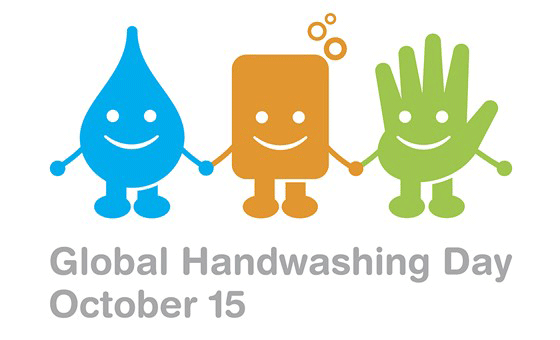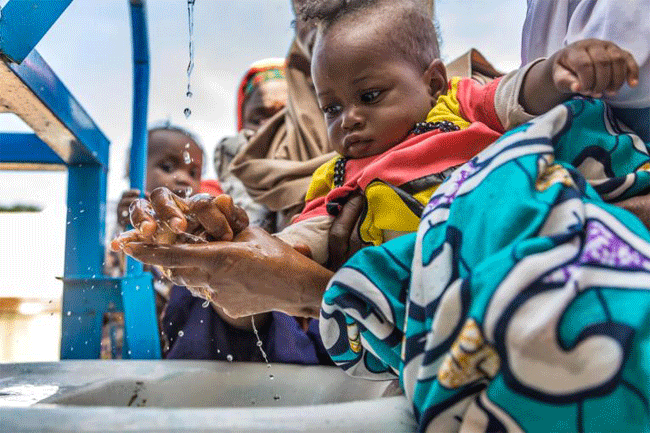유니세프, “전세계 23억명이 집에서 손 씻을 수 없어”
“10명 중 3명이 집에서 감염병 퇴치 위한 기본적인 손씻기 시설이 없다”경고
매년 10월 15일은 ‘세계 손 씻기 날(Global Handwashing Day)’

전 세계적으로 ‘코로나19(COVID-19)’를 포함한 전염병과의 싸움에서 비누로 손을 씻는 것이 중요하지만 약 10명 중 3명(23억 명)이 집에 물과 비누로 손을 씻을 수 있는 시설이 없는 것으로 나타났다.
유니세프(UNICEF ; 국제아동기금)는 10월 15일 ‘세계 손 씻기의 날(Global Handwashing Day)’을 맞아 10명 중 6명 이상이 기본적인 손 위생을 받지 못하는 등 최빈국에서 상황이 최악이라고 경고했다.
유니세프의 WASH(Water, Sanitation and Hygiene ; 물과 위생시설 및 위생) 담당이사인 켈리 앤 네일러(Kelly Ann Naylor)는 “팬데믹(pandemic)에 대한 세계적인 대응 노력은 손 위생을 위한 전례 없는 시간을 만들었다. 그러나 가장 취약하고 소외된 지역 사회에 대한 진전은 여전히 너무 느리다”라고 말했다.
켈리 앤 네일러(Kelly Ann Naylor) 이사는 특히 “손 위생은 ‘코로나19(COVID-19)’ 관리를 위한 임시방편으로 볼 수 없다. 물, 위생시설 및 위생(water, sanitation and hygiene ; WASH)에 대한 장기적인 투자는 다음 건강 위기를 예방하는 데 도움이 될 수 있다. 또한 호흡기 감염에 걸리는 사람이 줄어들고 설사병으로 사망하는 어린이가 줄어들며 패혈증과 같은 예방 가능한 질병으로부터 보호받는 임산부와 신생아가 늘어날 것이다”라고 강조했다.

최신 데이터에 따르면 2015년 이후 어느 정도 진전이 있었다. 예를 들어, 집에서 기본적인 손 위생을 이용할 수 있는 전 세계 인구는 50억 명에서 55억 명으로 또는 67%에서 71%로 증가했다. 그러나 현재 추세가 지속된다면 19억 명의 사람들이 향후 10년까지 기본적인 손 위생에 접근하지 못할 것이다.
- 최신 추정치에 따르면, 전 세계적으로 10명 중 3명(23억 명)이 집에서 물과 비누로 기본적인 손 씻기 시설을 이용할 수 없으며, 여기에는 시설이 전혀 없는 6억7천만 명이 포함된다. 최빈국에서는 10명 중 6명 이상이 집에 기본적인 손 위생 시설이 부족하다.
- 전 세계 학교 5곳 중 2곳은 물과 비누로 기본적인 위생 서비스를 제공하지 않아 8억1천800만 명의 학생이 영향을 받고 있으며, 그 중 4억6천200만 명이 시설이 전혀 없는 학교에 다니고 있다. 최빈국에서는 학교 10곳 중 7곳이 아이들이 손을 씻을 곳이 없다.
- 전 세계 의료 시설 3곳 중 1곳은 환자, 의료 종사자 및 치료가 환자와 접촉하는 진료 지점에 손 위생 시설이 없다.
- 2030년까지 세계 최빈국 46개국의 모든 가정에서 손 위생을 제공하는 데 드는 비용은 약 110억 달러로 추산된다. 위생 증진을 위해 정부가 지출하는 비용은 연간 1인당 25센트에 해당하는 것으로 추산된다.

최빈 개발도상국은 아프가니스탄, 앙골라, 방글라데시, 베냉, 부탄, 부르키나파소, 부룬디, 캄보디아, 중앙아프리카공화국, 차드, 코모로, 콩고민주공화국, 지부티, 에리트레아, 에티오피아, 감비아, 기니, 기니비사우, 아이티 , 키리바시, 라오스, 레소토, 라이베리아, 마다가스카르, 말라위, 말리, 모리타니, 모잠비크, 미얀마, 네팔, 니제르, 르완다, 상투메프린시페, 세네갈, 시에라리온, 솔로몬 제도, 소말리아, 남수단, 수단, 동티모르, 토고, 투발루, 우간다, 탄자니아 공화국, 예멘, 잠비아 등이다.
또한 접근과 발전에 있어 국가 안팎에 깊은 불평등이 존재하며 가장 취약한 어린이와 가족이 가장 고통을 받는다. 더욱이, 취약하고 분쟁의 영향을 받는 난민 환경에서는 진행 속도가 특히 느리다.
- 취약한 상황에서 5명 중 1명은 집에 손 위생시설이 없다.
- UNHCR(유엔난민기구)에 데이터가 있는 20개국 중 8개국에서 난민 가구의 30% 이상이 비누를 사용할 수 없다.
- 전 세계적으로 현재 진행률이 2030년까지 보편적인 위생 상태에 도달하려면 4배가 되어야 한다. 최빈국에서는 진행률이 10배 증가해야 하며 취약한 상황에서는 23배 빨라야 한다.
유니세프는 정부가 전염병에 대한 일시적인 대응이 아니라 공중 보건 및 경제 회복력에 대한 투자로 손 위생을 제공할 것을 촉구하고 있다.
유니세프와 WHO(세계보건기구)의 최신 공동 보고서는 정부가 손 위생에 대한 접근을 신속하게 확대할 수 있도록 하는 5가지 가속기를 식별합니다. 여기에는 좋은 거버넌스, 스마트 공공 재정, 역량 구축, 일관된 데이터 및 혁신이 포함된다.

[원문보기]
On Global Handwashing Day, UNICEF warns that 3 in 10 people do not have basic handwashing facilities at home to fight off infectious diseases
NEW YORK, 15 October 2021 - Although handwashing with soap is critical in the fight against infectious diseases, including COVID-19, globally, around 3 in 10 people ? or 2.3 billion ? do not have handwashing facilities with water and soap available at home.
The situation is worst in the least developed countries, with over 6 in 10 people without access to basic hand hygiene, UNICEF warned on Global Handwashing Day.
“Global response efforts to the pandemic have created an unprecedented time for hand hygiene. Yet progress remains far too slow for the most vulnerable, underserved communities,” said UNICEF WASH Director Kelly Ann Naylor.
“Hand hygiene cannot be viewed as a temporary provision to manage COVID-19. Further long-term investment in water, sanitation and hygiene can help prevent the next health crisis from coming. It also means fewer people falling ill with respiratory infections, fewer children dying from diarrheal diseases, and more pregnant mothers and newborns protected from preventable conditions like sepsis.”
The latest data show that some progress has been achieved since 2015. For example, the global population with access to basic hand hygiene at home has increased from 5 billion to 5.5 billion, or from 67 per cent to 71 per cent. However, if current trends persist, 1.9 billion people will still not have access to basic hand hygiene by the end of the decade.
- According to the latest estimates: Globally, 3 in 10 people - or 2.3 billion - do not have access to basic handwashing facilities with water and soap at home, including 670 million people without any facility at all. In the least developed countries, more than 6 in 10 people lack basic hand hygiene facilities at home.
- 2 in 5 schools worldwide do not have basic hygiene services with water and soap, affecting 818 million students, of which 462 million attend schools with no facility at all. In the least developed countries, 7 out of 10 schools have no place for children to wash their hands.
- 1 in 3 healthcare facilities worldwide does not have hand hygiene facilities at points of care where the patient, healthcare worker, and treatment involve contact with the patient.
- The cost to provide hand hygiene in all homes in 46 of the world’s least-developed countries by 2030 is an estimated US$11 billion. The cost to governments for hygiene promotion are estimated to be equal to 25 cents per capita per year.
Least Developed Countries: Afghanistan, Angola, Bangladesh, Benin, Bhutan, Burkina Faso, Burundi, Cambodia, Central African Republic, Chad, Comoros, Democratic Republic of the Congo, Djibouti, Eritrea, Ethiopia, Gambia, Guinea, Guinea-Bissau, Haiti, Kiribati, Lao People’s Democratic Republic, Lesotho, Liberia, Madagascar, Malawi, Mali, Mauritania, Mozambique, Myanmar, Nepal, Niger, Rwanda, Sao Tome and Principe, Senegal, Sierra Leone, Solomon Islands, Somalia, South Sudan, Sudan, Timor-Leste, Togo, Tuvalu, Uganda, United Republic of Tanzania, Yemen, Zambia.
Deep inequalities exist across and within countries regarding access and progress, with the most vulnerable children and families suffering the most. Moreover, in fragile, conflict-affected, and refugee settings, progress is especially slow:
- In fragile contexts, 1 in 5 people do not have any hand hygiene facility at home.
- In 8 out of 20 countries for which UNHCR has data, more than 30 per cent of refugee households do not have access to soap.
- Globally, current progress rates must quadruple to reach universal hygiene by 2030. In the least developed countries, the rate of progress would need to increase ten-fold, and in fragile contexts, it would need to accelerate by a factor of 23.
UNICEF urges governments to commit to providing hand hygiene, not as a temporary response to the pandemic, but as an investment in public health and economic resilience.
The latest joint UNICEF and WHO report identifies five accelerators that can enable governments to rapidly scale up access to hand hygiene, including good governance, smart public finance, capacity building, consistent data, and innovation.

